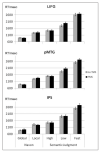Executive semantic processing is underpinned by a large-scale neural network: revealing the contribution of left prefrontal, posterior temporal, and parietal cortex to controlled retrieval and selection using TMS
- PMID: 21861680
- PMCID: PMC3542522
- DOI: 10.1162/jocn_a_00123
Executive semantic processing is underpinned by a large-scale neural network: revealing the contribution of left prefrontal, posterior temporal, and parietal cortex to controlled retrieval and selection using TMS
Abstract
To understand the meanings of words and objects, we need to have knowledge about these items themselves plus executive mechanisms that compute and manipulate semantic information in a task-appropriate way. The neural basis for semantic control remains controversial. Neuroimaging studies have focused on the role of the left inferior frontal gyrus (LIFG), whereas neuropsychological research suggests that damage to a widely distributed network elicits impairments of semantic control. There is also debate about the relationship between semantic and executive control more widely. We used TMS in healthy human volunteers to create "virtual lesions" in structures typically damaged in patients with semantic control deficits: LIFG, left posterior middle temporal gyrus (pMTG), and intraparietal sulcus (IPS). The influence of TMS on tasks varying in semantic and nonsemantic control demands was examined for each region within this hypothesized network to gain insights into (i) their functional specialization (i.e., involvement in semantic representation, controlled retrieval, or selection) and (ii) their domain dependence (i.e., semantic or cognitive control). The results revealed that LIFG and pMTG jointly support both the controlled retrieval and selection of semantic knowledge. IPS specifically participates in semantic selection and responds to manipulations of nonsemantic control demands. These observations are consistent with a large-scale semantic control network, as predicted by lesion data, that draws on semantic-specific (LIFG and pMTG) and domain-independent executive components (IPS).
Figures




Similar articles
-
Automatic and Controlled Semantic Retrieval: TMS Reveals Distinct Contributions of Posterior Middle Temporal Gyrus and Angular Gyrus.J Neurosci. 2015 Nov 18;35(46):15230-9. doi: 10.1523/JNEUROSCI.4705-14.2015. J Neurosci. 2015. PMID: 26586812 Free PMC article.
-
Going beyond inferior prefrontal involvement in semantic control: evidence for the additional contribution of dorsal angular gyrus and posterior middle temporal cortex.J Cogn Neurosci. 2013 Nov;25(11):1824-50. doi: 10.1162/jocn_a_00442. Epub 2013 Jul 16. J Cogn Neurosci. 2013. PMID: 23859646
-
The neural organization of semantic control: TMS evidence for a distributed network in left inferior frontal and posterior middle temporal gyrus.Cereb Cortex. 2011 May;21(5):1066-75. doi: 10.1093/cercor/bhq180. Epub 2010 Sep 17. Cereb Cortex. 2011. PMID: 20851853 Free PMC article.
-
The neural basis of semantic cognition: converging evidence from neuropsychology, neuroimaging and TMS.Cortex. 2013 Mar;49(3):611-25. doi: 10.1016/j.cortex.2012.10.008. Epub 2012 Nov 13. Cortex. 2013. PMID: 23260615 Review.
-
The neurocognitive basis of knowledge about object identity and events: dissociations reflect opposing effects of semantic coherence and control.Philos Trans R Soc Lond B Biol Sci. 2020 Feb 3;375(1791):20190300. doi: 10.1098/rstb.2019.0300. Epub 2019 Dec 16. Philos Trans R Soc Lond B Biol Sci. 2020. PMID: 31840592 Free PMC article. Review.
Cited by
-
The meaning of 'life' and other abstract words: Insights from neuropsychology.J Neuropsychol. 2016 Sep;10(2):317-43. doi: 10.1111/jnp.12065. Epub 2015 Feb 23. J Neuropsychol. 2016. PMID: 25708527 Free PMC article. Review.
-
Intrinsic connectivity of left ventrolateral prefrontal cortex predicts individual differences in controlled semantic retrieval.Neuroimage. 2022 Feb 1;246:118760. doi: 10.1016/j.neuroimage.2021.118760. Epub 2021 Dec 4. Neuroimage. 2022. PMID: 34875381 Free PMC article.
-
Cathodal tDCS of the bilateral anterior temporal lobes facilitates semantically-driven verbal fluency.Neuropsychologia. 2018 Mar;111:62-71. doi: 10.1016/j.neuropsychologia.2018.01.009. Epub 2018 Jan 11. Neuropsychologia. 2018. PMID: 29337133 Free PMC article.
-
Neurocognitive insights on conceptual knowledge and its breakdown.Philos Trans R Soc Lond B Biol Sci. 2013 Dec 9;369(1634):20120392. doi: 10.1098/rstb.2012.0392. Print 2014. Philos Trans R Soc Lond B Biol Sci. 2013. PMID: 24324236 Free PMC article. Review.
-
Differing contributions of inferior prefrontal and anterior temporal cortex to concrete and abstract conceptual knowledge.Cortex. 2015 Feb;63:250-66. doi: 10.1016/j.cortex.2014.09.001. Epub 2014 Sep 22. Cortex. 2015. PMID: 25303272 Free PMC article.
References
-
- Amunts K, Schleicher A, Burgel U, Mohlberg H, Uylings HB, Zilles K. Broca’s region revisited: Cytoarchitecture and intersubject variability. Journal of Comparative Neurology. 1999;412:319–341. - PubMed
-
- Amunts K, Weiss PH, Mohlberg H, Pieperhoff P, Eickhoff S, Gurd JM, et al. Analysis of neural mechanisms underlying verbal fluency in cytoarchitectonically defined stereotaxic space—The roles of Brodmann areas 44 and 45. Neuroimage. 2004;22:42–56. - PubMed
-
- Badre D. Cognitive control, hierarchy, and the rostro-caudal organization of the frontal lobes. Trends in Cognitive Sciences. 2008;12:193–200. - PubMed
-
- Badre D, D’Esposito M. Functional magnetic resonance imaging evidence for a hierarchical organization of the prefrontal cortex. Journal of Cognitive Neuroscience. 2007;19:2082–2099. - PubMed
-
- Badre D, Poldrack RA, Pare-Blagoev EJ, Insler RZ, Wagner AD. Dissociable controlled retrieval and generalized selection mechanisms in ventrolateral prefrontal cortex. Neuron. 2005;47:907–918. - PubMed
Publication types
MeSH terms
Grants and funding
LinkOut - more resources
Full Text Sources
Medical

